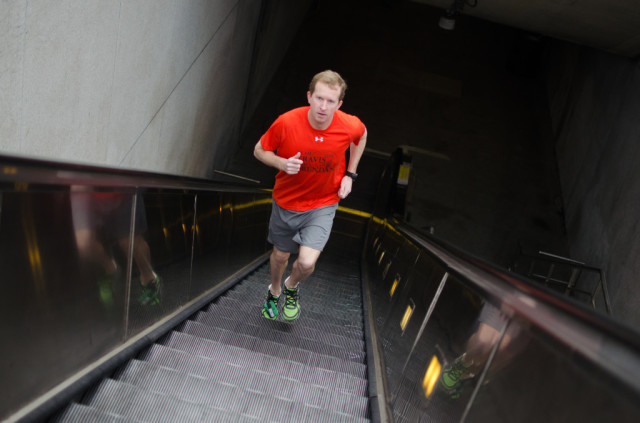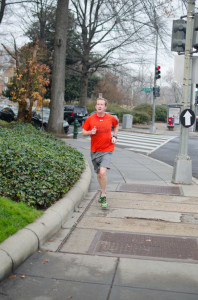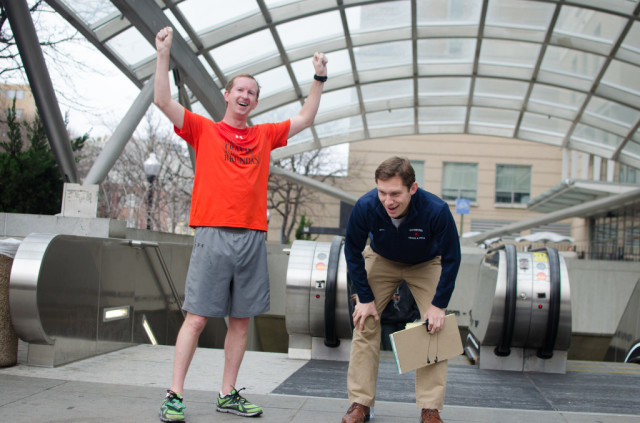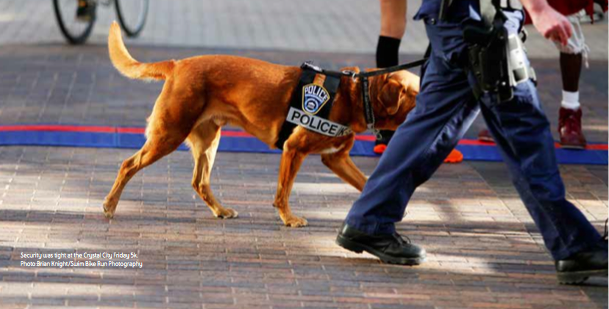
It’s a Sunday morning in December, a few minutes past 9. The weather is gray and cool and still, perfect for running.
RunWashington Editor in Chief Charlie Ban and Patrick Benko, who is 32 and a relatively recent running convert, meet at the chosen starting line: the gates to the Van Ness Metro station in Northwest Washington, D.C.
A train bound for Glenmont takes them both by surprise when it pulls into the station, Charlie yells out, “GO!, GO!” And like that, they split – Charlie, with his notebook, down the escalator towards the platform; Patrick, dressed to run, up the escalator towards the street.
The finish line is the entrance to the Foggy Bottom station, where escalators meet sidewalk.
To be clear, this race is not in any way intended to be some sort of commentary on D.C.’s Metro. This was just a little experiment – a bar bet, if you will. We wanted to make the race as fair as possible, to set a good example for runner safety, to obey all Metro rules (at least the ones we are aware of), and, lastly, gain a heightened sense of how – on the weekend, anyway – steel wheels on rail compare to sneakers on pavement.
Patrick faces about three and a half miles of sidewalks, and has agreed to obey all stop signs and traffic signals.
Charlie, in turn, faces roughly 20 to 30 minutes of public transiting. That includes five stops on the red line to Metro Center; a transfer; three stops on the Orange-and-Blue line to Foggy Bottom; and a controlled hustle (no running in the Metro!) from the platform to the street.
Patrick has a 5k personal best of 20:02. Charlie, well, Charlie has a rapid transit system that much of the time really is.
So, before we go further with this, place your bets. Who will win?
Man or runner?
Patrick on foot or Charlie via Metro?
Actually, before you get serious about your bet, let us tell you more about our competitors.
Patrick Benko, you should know, has already beaten the Metro at least once on foot. One of those times occurred on a Wednesday morning in September, when power failures caused major delays on Metro’s red line, which Patrick uses to commute from Shady Grove (near his home in Gaithersburg) to Chinatown (the closest stop to his job at the American Public Health Association, where he specializes in online marketing).
While some Metro riders were forced to evacuate the red line that day in September, Patrick’s decision to evacuate in Friendship Heights was entirely his own. Why not? He planned to run during his lunchtime, anyway. So rather than make like a sardine in a crowded train, he exited the station and took off running. An hour later, Patrick was at his desk and the train was still stuck in the tunnel. And, Patrick had already gotten his run in.
As it happens, Patrick runs about 30 miles per week, and has made exiting the red line to go running a regular habit.
In fact, according to Patrick math, one minute on the train equals two minutes of running.
And seriously, who reading this magazine wouldn’t want to trade 30 minutes of commuting with an hour of running?
Sometimes he gets off the Metro in Bethesda and runs down the Capital Crescent Trail. Other times, he gets off at Van Ness and runs south on Connecticut Avenue. He carries his work clothes in a Camelbak backpack; on his off days, he carries an extra set of work clothes to lighten his load on the days he runs. He showers when gets to work. And, with good planning, Patrick attests, side trips to Macy’s to buy a belt before the big meeting are easily avoided.
Patrick emerges onto the streets outside Van Ness, starts his watch, and takes off running South on Connecticut.
This is the runners’ hour, when the streets are practically empty, when it’s quiet enough to hear birds. There are enough hours between now and brunch, you figure, that many hangovers have yet to be realized. The car horns have yet to return. The sidewalks have yet to fill up. And the city, at least for now, feels like it’s all yours.
Patrick is running comfortably hard and steady, a couple minutes off his 5k PR pace.
Occasionally, he passes by a runner heading north. He passes a contemplative soul taking a picture of a tree with his phone. He passes people milling about with their coffees. “On your left,” he shouts, as he passes a young man dragging a rolling suitcase.
You can hear the whine of the escalators as he passes the Cleveland Park station. Pretty soon he’s cruising past the Woodley stop.
Crossing the Connecticut Avenue Bridge, his eyes stay focused on the road ahead, his memorized route – not the trees and water and running paths of Rock Creek Park far below.
He had done a test run of his route on Friday morning – at a time no doubt, when the Metro would have been harder to beat.
But he’s having one of those city runs today where everything seems to be conspiring in his favor. In other words, he’s catching all the walk signs. It’s not until Calvert, in fact, that he has to come to a complete stop, and even then it’s only for a second or two that only seems to refresh him a bit before he surges on.
This race is neck and neck.
And below ground, previously-unthought-of-efficiencies of weekend Metro riding reveal themselves: like the absence of people ignoring warnings to, as it goes, stand clear of the closing doors.
Charlie is loving it. He has two seats to himself. He has a newspaper to read. Dude’s content.
But he’s also alert. He knows his transfer in Metro Center is critical. He won’t have much time, you see, to hit a quick transfer to the Orange- and-Blue that could more or less guarantee himself a perch on I Street, where he could stand there reading his Kindle and pretend not to even notice Patrick entering his kick as he turns off Washington Circle.
Entering the Metro Center platform, he heads to the nearest escalator. It seems, at first glance, that everyone is standing on the right side. But it only takes one, and one there is. On his way down the escalator Charlie sees the train pulled up to the platform, doors open. Charlie clears his throat; it doesn’t work. Finally, he says out loud, “walk, please,” which doesn’t work, either.
He reaches the bottom of the escalator just as the doors close. Making matters worse, as the train pulls away, he looks up at the
board and sees “14 minutes,” like some grossly positive split that has no doubt doomed his race.
He takes a seat on a granite bench and sulks, thinking about all the ground Patrick is covering above.
But wait! Charlie almost got on the wrong train! The right train is only a minute away!
This race is back on!
Charlie clocks an 8:47 transfer. Now he’s back on the train, moving again, confident.
Patrick, meantime, hangs a smooth right on Florida, gliding between a small group at the corner. He spots a walk sign and, after looking both ways, darts through a crosswalk.
He crosses Mass Ave. He’s on 22nd bound for K Street and Washington Circle, the end in sight.
All of this would have seemed so improbable just a few years ago.
Patrick had played sports in high school and college. But for a decade after that, he was largely inactive, and a smoker.
He quit smoking in 2010. That year, he also started training for the Marine Corps Marathon so he could run it for Team Travis and Brendan, which raises money for the Travis Manion Foundation.
Marine 1st Lt. Travis Manion and Lt. (SEAL) Brendan Looney were best friends and U.S. Naval Academy roommates who both made the ultimate sacrifice. Patrick attended high school with Looney.
Even so, Patrick says, were it not for his wife, Jackie Benko, he could have been a one-and-done marathoner. When
he joined Montgomery County Road Runners’ first-time marathoners group in 2010, Jackie joined, too – figured she’d keep her husband company. Now they’ve run MCM three years in a row, and Patrick has his sights set on the upcoming Rock-n-Roll USA Half Marathon.
As he double-steps the Foggy Bottom escalators, Charlie is sure victory is his. But as he gets closer to the street, he recognizes Patrick’s bright-orange Team Travis and Brendan shirt, and, at the top, graciously accepts his defeat.
Patrick, according to his watch, has covered 3.34 miles in 22:24, with less than 15 seconds of that spent not running. He hit an average pace of 6:43 per mile, just as he said he would.
Charlie, and the Metro, they had a good “run,” too, coming in only about a minute behind.
But for Patrick, with three marathons under his belt now and a new year approaching, the win is sweet – confidence boosting, even. He has a good story, maybe one that will inspire future generations.
On a Sunday morning in December, Patrick Benko laced up his shoes, took off running, and beat the machine.
He also got in a solid tempo run.
Two years later, D.C.’s Alison Meek attempted a shorter but less complex challenge- sprinting between the Federal Triangle and Smithsonian stations to see if she could catch the same train, after .4 miles of running. Her 3:36 time wasn’t enough, but she caught the train immediately following the one she disembarked.
You can see the video she and friends made here.
This story originally appeared in the February/March 2013 issue of RunWashington.
Here comes your shirt.
You are at an expo; and after you say your size, a volunteer picks it out of a mini-mountain of them and hands it to you, after which you stuff it in your token plastic bag, or maybe you hold it out in front of you with two hands, size it up like a painting, then decide in seconds whether it’s a keeper, a rag, or ironic.
It could be short sleeve, long sleeve, cotton, “technical,” designed by a budding 10-year-old artist, or be pure retina-burning color. But that’s not the point.
The point is that some runners say you are better off crossing paths with a black cat than putting on that shirt at any time before you cross that finish line.
But, it’s just a shirt, you say? How can a shirt wipe out all those miles run, all those lung-searing intervals, all those perfect simple-carb meals?
Ask Dave Nemetz, 47.
On two occasions, Nemetz has tried on his shirt before the gun fired.
In 2009, he tried it on the night before the Philadelphia Distance Run and the next day strained his calf and dropped out.
In 2010, before a summer race in Dewey Beach, Del., he picked up the shirt on race day, walked to the start, and, since he did not have anywhere to put the shirt, wore it. This time, Nemetz strained his calf after only one tenth of a mile.
The Reston resident has been running for four years and has done about 35 races. (“I keep all of my (race) shirts,” he says, “until I can’t get the sweat smell out of them anymore.”)
Since Dewey, though, Nemetz, under no circumstance, will try on a race shirt at any point before the start. Since then, coincidentally, or maybe not, he has never pulled out of a race with a calf issue.
Could dehydration be the real culprit? Nemetz, who now has two more years of running under his belt, more or less admits as much.
But he’s not about to swear off his superstition, either.
Runners, no doubt, are a superstitious lot. We have this tendency to assign luck – both good and bad – to articles of clothing, to food, and more.
Sometimes we call them rituals. Sometime we call them quirks.
Sometimes we say running is all mental.
I suppose we’ll do anything to calm down our nerves, anything to keep those negative thoughts from creeping in.
Thank you, Dave Nemetz, for sharing with us your superstition. Thank you, as well, to the local runners – whose stories are below – for lifting up the curtain on race day, and for giving us a glimpse of that weird intangible factor the more sophisticated among us sometimes call the mind-body-spirit.
It’s all about the shoes
Brandon Hirsch rotates each racing flat clockwise – twice – before he puts them on. He counts to 30, takes each shoe off, and rotates them again – this time counterclockwise – before putting them on for real.
The technology lawyer’s singlet goes on inside-out. After his warm-up, he takes it off and flips it.
There are 20 minutes until race time. And somewhere deep inside his nervous mind, someone is pumping quarters into a jukebox and choosing Don McLean’s “American Pie” – again and again and again.
The third verse, in particular, seems to be playing on loop:
Helter skelter in a summer swelter
The birds flew off with a fallout shelter Eight miles high and falling fast.
Next comes the playing of the national anthem. After that comes the surreal scene where Hirsch, 42, of Rockville, unties and ties his shoes. And after that, the race is finally on, and Hirsch can just run.
For Hirsch, superstitions are a kind of coping mechanism to deal with high levels of pre-race nerves. In his 20s, he ran the Boston Marathon in 2:38:12. He then suffered a string of injuries, had his priorities shift towards other things, then spent the next 14 years jogging.
He returned to racing in 2009, this spring clocking 36:29 at the Pike’s Peek 10k. Meanwhile, since returning to racing, Hirsch has found that today’s scene hardly mirrors the one he remembers from his 20s. In short, today’s more festive pre-race atmosphere kind of freaks him out. And to be fair, Hirsch’s rotating of his shoes and his singing of “American Pie” – the lyrics for which he used to scribble in his notebooks in grade school when a teacher stressed him out – isn’t entirely random, either.
Hirsch grew up playing basketball, even played in college. One summer, the great UCLA basketball coach John Wooden visited his camp. And get this: Wooden’s first drill with these young basketball players addressed the proper way to put on your shoes and socks.
Hirsch recalls, “He said, ‘Hey, I showed Bill Walton how to do this.’”
The Learned Routine
Before her high school track races, Miriam Becker-Cohen always had to read a motivational letter written to her by an older teammate. It didn’t matter that the letter really wasn’t that motivational. Reading it was a superstition. And back then, Becker-Cohen, now 25, had an assortment of similar superstitions she turned to on race day.
But Becker-Cohen has since left the majority of those superstitions behind. Today, the habits the Washington, D.C. resident and DC Road Runners Club member relies on to race her best could alternatively be described as rituals or a routine.
She lays out all of her clothes the night before the race, pins her bib to her shirt.
Race mornings she has two slices of toast, some Gatorade, and about two liters of water. And lately, right before the race, she downs a Powerbar Gel Blast – 10 measly strawberry-banana calories that let her brain and legs know the time is now.
“It has a lot to do with the fact that running is so mental, and having some sort of routine can mentally prepare you in a way that puts you at ease,” she says.
One of the more frustrating parts of the marathon, for example, is that months of great training have the potential to be unraveled by an alarm clock that fails to go off or by eating the wrong breakfast – by race day logistics, essentially.
So part of the reason that Becker-Cohen is so serious about doing things the same way over and over is that, ultimately, this is what makes her feel more prepared and less rushed on race day.
She likes to be at the start earlier than a lot of people.
Why? Before the Philadelphia Marathon one year she had to sprint to the starting line to be there before the gun went off. She got flustered, went out too hard, had a “terrible” race.
She would rather have things go down the way they did in October at the Steamtown Marathon, where, in her fourth attempt to do so, she qualified for the Boston Marathon.
“There is only so much training you can do, and there are good days and bad days,” she says. “But if you have things that work for you in the past, it does become sort of like a superstition.”
Something to Chew on
Shortly before the 2012 Disney World Marathon, Matthew Lofton realized that his gum had fallen out of his pocket.
No big deal, right?
Actually, for Lofton, it was a huge deal.
Oh my gosh. This is off to a bad start, he thought.
Panicking, the 33-year-old Winchester, Va. resident started asking race volunteers if they could spare some. (Lofton, lucky for him, doesn’t need a lot of gum: One piece can last him three or four hours, he says, and he doesn’t even necessarily need to chew on it the whole time.)
After scrounging up that stick of gum, the photographer and running coach went on to run 2:46, roughly an hour faster than his debut couch-to- marathon effort just four years prior.
Lofton will make sure to pack his gum when he heads to Boston this fall. In the meantime, while he trains for it, he will make sure to have a stick in his car, a stick in his running bag, and plenty of extra packs at home – anything to prevent having to run gum-free.
Lofton describes himself as “slightly OCD.”
For example, he has eaten at Burger King – ordering the same meal – every Saturday going on six years. But many of his habits – or streaks, if you will – like wearing the same socks for races, do in time fade away (the socks, for instance, wore out).
Not gum.
“I don’t see myself ever running without gum,” he says. “That seems really weird to me to run without it.”
Got Beer
Kim Kruse, 48, of Arlington had a habit of swearing off alcohol for two months before a marathon.
How disciplined and smart.
But one night before a triathlon several years ago, Kruse was at a restaurant and got into a conversation about the effect alcohol had on racing.
Her friend was pretty sure beer drinking was no good. Kruse, in turn, was pretty sure having a beer couldn’t possibly hurt.
So, a bet was placed, and Kruse ordered a beer. The next day she had a great race, and won the bet: a six-pack of her choice.
Kruse now has a beer before every race.
“It’s important to me because I have travelled to some very cool places for racing and I like to drink local beers,” she says.
In fact, Kruse, a member of DC Road Runners Club, placed third in her age group at the National Long Course Championship triathlon, qualifying her to represent Team USA at the 2013 Long Course World Championship in France.
If she were a pro athlete, she figures, and racing was her true “bread and butter,” she might second-guess this pre- race ritual.
“But I am not a pro,” she says, “and my beer goes well with bread and butter.”
A Kiss for Good Luck
In 2007, Glenn Sewell of Arlington watched from the sidelines as his wife, Jenny Goransson, ran the Marine Corps Marathon. He was joined that day by Goransson’s mother, who made sure they saw Goransson at as many mile markers as they could.
Afterward, Sewell was exhausted, and he joked to his wife that perhaps running it would be easier. So, he took up running. And two years later, he really did finish MCM, the first of his three marathons.
Sewell has yet to catch up to his wife, who last year finished the Shamrock Sportsfest Marathon in 3:19. But they generally run the same races, from 5K to marathons.
So what does Sewell always need right before the race starts? A kiss, of course.
“She’s much faster than I am, so I always hope it will give me a boost of her speed,” he says.
As Sewell has improved, the meaning of the kiss has shifted. At first, it was a kiss meaning, “good luck getting to the finish.” These days, it means, “good lucking trying to snag a PR.”
Regardless, without that pre-race smooch from Jenny, Sewell, 47, says he struggles to bring his A game.
“I am not sure if I miss it I think I am inviting bad luck. But I do know that it affects me mentally.”
The usual plan for the George Washington Parkway Classic calls for securing a 10-mile, point-to-point course that starts at Mount Vernon, proceeds along George Washington Memorial Parkway, and finishes in Alexandria – a short walk away from Oronoco Bay Park. This means, on one hand, that some sort of barrier must stand between every driver and every possible opportunity to unknowingly or knowingly enter the race course. On the other, it means that course marshals and police officers must be ready to stand by and enforce these barriers; and, should the unthinkable happen – a vehicle on the course – the plan includes being ready for that, too.
There is the job of safely transporting 6,000-or-so runners from an area near the finish – where many park – to the start. There is the readiness for any on-course injuries. There are risk management strategies. And yes, there is water, and sports drinks, and gel packs, and clocks at mile markers.
That’s not it – not even close. But two more things: The Alexandria Police Department, for this year’s race, wanted to honor a colleague who was seriously injured in a shooting, and, on a related note, make the last mile special for participants.
Twenty-five year force member Sgt. Joseph Seskey and the members of his special events unit envisioned – with about a mile to go – a line of police officers there to greet the runners, many of whom wore honorary bibs for Officer Peter Laboy, the man injured, on their backs. “So you turn that corner,” Seskey said, “and it kind of grabs you: everyone coming together to support Peter.”
Six days before the Parkway Classic, tragedy struck the Boston Marathon.
An hour later, Seskey was on the phone with Kathy Dalby, founder of Pacers Events, which organizes the race.
The officers scheduled to stand strong for Peter Laboy were reassigned to other race day duties. Contingency planning for “enhanced security,” years in the making, quickly took shape.
“We knew we had to make some changes,” Seskey said, “and be out in front. Within an hour from Boston … everybody was thinking alike. We all just knew what we needed to do.”
In addition to Alexandria police and Pacers Events, “everyone” included U.S. National Park Police, whose jurisdiction covers better than three quarters of the course, fire and rescue units, and additional local and federal agencies whose services were suddenly in high demand.
Sanitation was called in to cover trash cans. Emergency management, intelligence, and special operations performed unseen jobs. The finish area was closed off to spectators, a mobile command center situated nearby.
Staffing was increased for specific locations, Seskey said. Extra bomb-sniffing dogs were present. Snipers manned rooftops, while extra police teams observed the crowd.
“We have always understood that any place that a lot of people assemble could be a possible target,” said Seskey, whose team is handling safety and threat assessments plans for an ever-increasing number of road races. “You just have to always be prepared. We kind of operate on that level without even knowing it, just because we have been doing it for so long.”
The Game Changer
What if there is a huge thunderstorm, or a gas leak, or an attack? How would you re-route or cancel the race? What’s the evacuation plan?
When police, fire departments, emergency services, and race organizers meet at the planning table months before an event, all these scenarios are on the table, Dalby said.
Twenty years ago, Marine Corps Marathon Race Director Rick Nealis remembers one thing that weighed heavily on many race directors’ minds was whether to put four or six ounces in the Dixie cups Marines would hold out for runners.
September 11 was a “game changer,” he said, explaining the increasing emphasis placed on safety and security rather than water, Vaseline, and bananas.
As if September 11 wasn’t enough, the D.C. sniper shooting occurred the follow October. The next year, America entered a second war, making MCM a potentially more inviting target, Nealis said.
There was a time when MCM runners could park in the Pentagon parking lot, a time when race day logistics didn’t include security checkpoints. There was also a time when the race didn’t sell out in less than three hours.
While you run MCM – through seven police jurisdictions – emergency crews are on standby, security alerts are taken and processed, police officers stand guard over barricades.
Some situations require quick decisions. During last year’s MCM 10K, which is held during the marathon, debris left over from the Army Ten-Miler, Nealis said, blew onto the course and looked like a suspicious package. The race was stopped until authorities could inspect it.
Afterward, while you analyze every last detail about your performance, so do organizers and their security partners.
“Each year,” Nealis said, “you sit back and you say, well, we could do this better.”
Enhanced Security
Jean Arthur remembers how quickly one driver’s irritation turned to rage.
She was standing beyond the sidelines of a local road race, a volunteer course marshal. The road was closed for the race, Arthur explained to the driver. The only option was to turn around.
The driver started yelling. A police officer, who heard the yelling, approached the car, and suddenly the driver seemed to have no problem at all.
Arthur is now the race director for the Pikes Peek 10k, a point- to-point, super-fast race, held this year on the same day as the Parkway Classic.
She took over the job in 2007. By now, she knows all of the police officers she works with on a first name basis.
For Pikes Peek she works with several police departments and two fire departments.
The traffic control plan is 50 pages long. And in the early morning, as a race truck heads out on the course to lay down cones, a police car follows with flashing lights.
Going back to her experience, Arthur has learned that police bring more than manpower to an event, but also a sense of legitimacy. Drivers encountering a truck going really slow on Route 355 in the early morning sometimes become annoyed, and having a police officer at her side provides “general protection.”
After she heard about the attack in Boston, Arthur contacted her event partners right away.
“Hey, Jean,” one police officer wrote her in a text message. “I got you covered. We’ll take care of you.”
Bomb sniffing dogs were at the start and finish of this year’s race, sniffing vehicles, bags, and portable toilets. An extra police officer roamed the course on a motorcycle.
Police officers at Pikes Peek, once on-course assignments are complete, typically report to their next assignment, but this year all of them provided extra security at the post-race festival.
“I think from here on out we have to take these extra precautions,” Arthur said.
Even so, how much will really change?
When you run a race in the District starting in front of Freedom Plaza, you probably aren’t thinking – are you even aware? – of the hundreds of cameras watching you, of “mass casualty” pre-planning, or reports of a suspicious car near the course.
Enhanced security, much like regular security, is both seen and unseen. So as race organizers and police officers, post-Boston, re-evaluate these plans, now is a good time to recognize how much safety and security infrastructure is already in place. This is the time to recognize all the planning that goes into closing roads so we can race in the middle of them, and the already essential role of police and fire crews and medical staff and emergency response units in allowing us to celebrate our sport.
The Parkway Classic was U.S Park Police Sgt. Ari Wong’s first race as head of the force’s special events unit.
“Coming into this job,” Wong said, “you really don’t have as much appreciation for what goes into it.”
For big races like the Parkway Classic, the planning begins many months in advance. Thus, by race day, every assigned officer’s task should be clear. “I do my job well,” Wong said, “if I don’t have very much to do on race day.”
Given the sheer volume of road races in the area, the job, Wong said, comes with its fair share of super-early weekend mornings.
But Wong, and Seskey both said they enjoy the work, and working with each other, on races that cover both police forces’ jurisdictions.
“There’s no lead agency,” Wong said. “We work together from day one.”
He added: “For all of us in law enforcement, the people running are our neighbors, our friends, our colleagues’ husbands and wives. We want it to be a special event for them. We want it to be safe.


